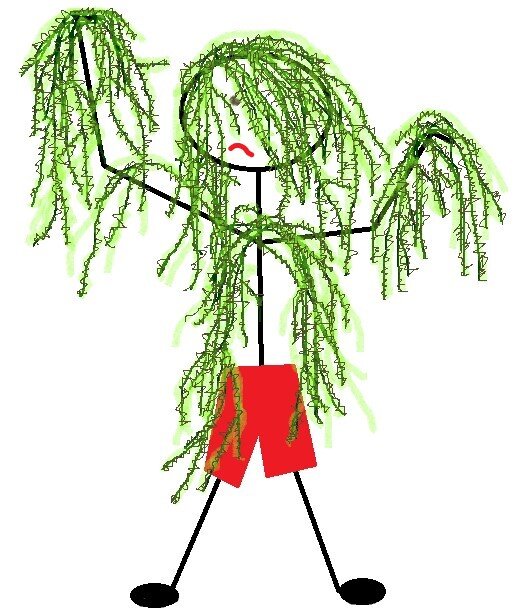By Katy Crandall, April Mulcahy, and Alex Pittman
Enter: Milfoil Kid Monster
Summer has finally arrived in Washington. You pack up the dog or your kids on a warm, sunny day, and head to a local lakeside park to soak in some Vitamin D and wear the little ones out (furry or otherwise). Your day at the beach is perfect…until your dog swims back with the fetching stick, cloaked with a wad of scratchy and smelly Eurasian watermilfoil…or your kid goes for a swim and emerges as a sea monster, covered in dangling green strands of aquatic weeds.
Aquatic noxious weeds, such as Eurasian watermilfoil, are a nuisance and not only impact recreational opportunities and the human-valued aesthetics of the environment, but also present significant challenges to our native ecosystems. Non-native aquatic weeds can displace native plants, impair habitat for fish, and negatively impact water quality.
Submerged hybrid watermilfoil is visible in the shallow nearshore waters of Cranberry Lake.
Case Study: Cranberry Lake
Cranberry Lake is a real-world example of the impacts and challenges posed by an infestation of an aquatic noxious weed. The 133-acre lake is located in Deception Pass State Park on the north end of Whidbey Island in Washington State. The park is a popular local and tourist attraction, and many visitors enjoy swimming, fishing, and using non-motorized boats.
Cranberry Lake contains a rich assortment of native aquatic plant species and unique ecological communities, but the lake also contains an extensive population of hybrid watermilfoil (Myriophyllum spicatum x M. sibiricum), which is a cross between the invasive Eurasian watermilfoil (Myriophyllum spicatum) and the native northern watermilfoil (Myriophyllum sibiricum). Hybrid watermilfoil is designated a Class C noxious weed by the Washington State Noxious Weed Control Board.
A Washington State Parks’ canoe floats near the public swim beach at the west end of lake, opposite the boat launch.
Invasive Aquatic Plant Transport and Regulation
Many aquatic noxious weeds spread rapidly, outcompeting and displacing native aquatic plants and associated animals. Eurasian and hybrid watermilfoil spread effortlessly through fragmentation: the plants break apart and take root in calm, shallow lake waters. This methods allows non-native watermilfoil to quickly colonize a water body and be easily and viably transported between lakes. Boats and boat trailers are common vectors for aquatic weeds like Eurasian and hybrid watermilfoil.
For example, during our field survey of Cranberry Lake, we found no Eurasian watermilfoil, which we also confirmed with genetic testing. Since hybrid watermilfoil develops where Eurasian and northern watermilfoil populations co-exist, we suspect the hybrid watermilfoil was transported to Cranberry Lake via fragments from a nearby lake containing both Eurasian and native watermilfoil. That lake likely became infested with Eurasian watermilfoil from fragments transported in boating or fishing equipment.
The Watershed Company surveyed aquatic vegetation in Cranberry Lake in July 2019. Plants were assessed and identified using a custom weed rake. Potential hybrid watermilfoil samples were collected for genetic analysis.
In the state of Washington, the intentional or unintentional release of non-native species between waterbodies is prohibited. Washington Department of Fish and Wildlife shares tips on how to prevent the spread of invasive species and recreate responsibly.
Registered boaters in Washington pay an annual $3 service fee that funds about $350,000 in grants each year to manage invasive aquatic plants (see more information on grant opportunities below).
Milfoil Kid Monster = Aquatic Noxious Weed…Now what?!
Many resources are available if you suspect or confirm the presence of an aquatic noxious weed in a waterbody which you would like to responsibly report and/or manage:
Hybrid watermilfoil is the dominant aquatic plant just below the surface of Cranberry Lake. Native plants in the photograph include Potamogeton praelongus and Elodea canadensis.
Report a Sighting on the Washington Invasive Species Council website. Your report is particularly valuable if the infestation is early or unknown and not yet widespread.
Some local jurisdictions, such as King County, offer technical assistance in aquatic plant identification, regulations, and weed control options; more information is available at their website here. King County also offers a free Lake Weed Watcher Training that trains volunteers to identify invasive and native aquatic plants.
For local and state governments, tribes, and special purpose districts, funding may be available for qualified projects through the Washington Department of Ecology’s Aquatic Invasive Plants Management Grants Program. Ecology administers three types of grants through this program, generally classified as planning, control, and early infestation project grants:
Planning: Involves development of an Integrated Aquatic Vegetation Management Plan (IAVMP) that identifies the invasive plant problem and evaluates management options. The Watershed Company, in coordination with Washington State Parks, developed an IAVMP for Cranberry Lake in 2019, which was subsequently approved by Ecology (read more about this work below). Application period: October 15th through November 15th.
Invasive Plant Control: With an Ecology-approved IAVMP in place, funds from this grant can be used to implement invasive plant control in accordance with the plan. Application period: October 15th through November 15th.
Early Infestation Project: Grant applicants may seek an early infestation project grant when a freshwater aquatic invasive plant is identified in the pioneer stages of growth in a lake, river, or stream. Applications may be submitted any time.
Cranberry Lake IAVMP
The Cranberry Lake IAVMP was led by a team of three Watershed professionals, incorporating expertise from their respective departments – Natural Resources, Environmental Planning, and Landscape Architecture – into the plan development. The goal of the IAVMP was to outline a method for control and eradication of hybrid watermilfoil that balanced the protection of important ecosystems associated with the lake.
A thorough aquatic vegetation survey of the lake formed the basis of the IAVMP and helped determine the existing conditions and extent of the invasion. We coordinated closely with state agencies and other experts to ensure the recommended management approach was unlikely to result in impacts to sensitive native vegetation assemblages that contribute to the habitat value of Cranberry Lake. Once the invasive plant management approach was drafted, Washington State Parks and The Watershed Company held a public meeting to solicit community feedback and comments on the management proposal.
Watershed’s IAVMP for Cranberry Lake included GIS-based maps of inventoried aquatic species, the prevalence of
invasive hybrid watermilfoil, and management recommendations.
Native Aquatic Vegetation
We found 22 native aquatic plant species during our inventory of Cranberry Lake, despite the growing infestation of invasive hybrid watermilfoil. Native aquatic plants are part of a dynamic and healthy ecosystem, especially by providing food and habitat. A diversity of native plants supports a diverse array of invertebrates, which in turn feed fish, birds, frogs, and other animals.
Native aquatic plants in Cranberry Lake include yellow pond lily – whose leaves float on the surface –coontail, buck-bean, duckweed, pondweed, and bladderwort!
Concerned about aquatic invasive plants in a lake or other waterbody near you? Interested in an aquatic plant survey, vegetation management plan, or obtaining grant funding for these efforts? Give us a call at (425) 822.5242. We would be happy to talk to you about your next project.














